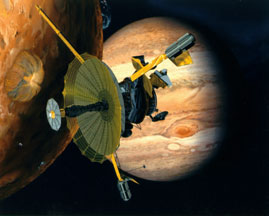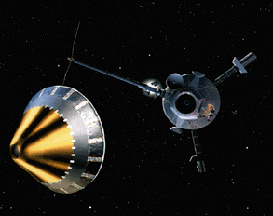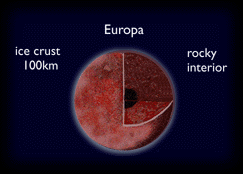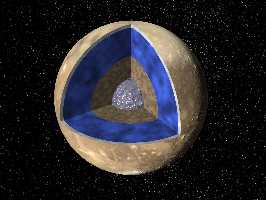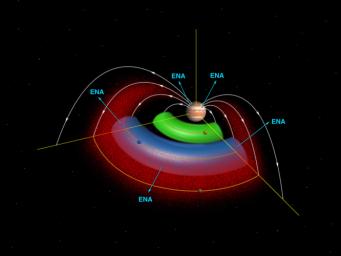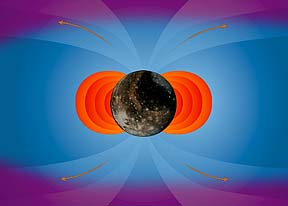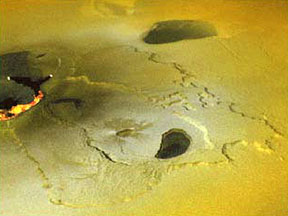Click on image for full size
Image courtesy NASA/JPL.
Related links:
Galileo Reaches the End of its Road
News story originally written on September 19, 2003
The Galileo spacecraft, which has been orbiting Jupiter since 1995, has finally reached the end of its road. On September 21, 2003, Galileo will make a fiery plunge into Jupiter's atmosphere and be vaporized. Galileo's demise is not an accident; mission planners have intentionally aimed the robotic spacecraft at the gas giant planet!
Galileo has far outlived the duration of its original mission. Its fuel supplies are dwindling, its power supply is getting low, and its instruments are failing after years of exposure to the intense radiation around Jupiter. Instead of shutting Galileo down and letting it drift in orbit around Jupiter, the Galileo mission team has placed the craft on a collision course with Jupiter. Why? Europa, one of Jupiter's moons, is one of the most likely places in the Solar System to harbor life. If Galileo is left to drift, there is a chance it might someday crash into Europa. Despite long years of exposure to the harsh environment space, there may be living microbes (or their spores) lurking somewhere inside the Galileo spacecraft. A crash into Europa could contaminate the moon with Earthly microbes.
Galileo has been a fabulously successful mission that has helped us learn a great deal about the largest planet in our Solar System, its many moons and complex rings, and the vast magnetic fields and deadly radiation belts that surround Jupiter. It is with a touch of sadness that we bid Galileo a fond farewell. Reflecting back on the long history of the Galileo mission, the scientists and engineers who conducted the mission recently assembled a list of some of Galileo's greatest accomplishments. Here they are:
- The descent probe (which plunged into Jupiter's atmosphere in December 1995) made measurements that furthered our understanding of how Jupiter has evolved. The measurements opened up new questions, however.
- Jupiter has numerous, large thunderstorms with a spatial extent that is different from the Earth. Galileo made a first observation of ammonia clouds in another planet's atmosphere. The atmosphere seems to create ammonia ice particles of material from lower depths, but only in "fresh" clouds.
- Evidence supports a theory that liquid oceans exit under Europa's icy surface.
- Galileo magnetic data provide evidence that not only Europa has a liquid-saltwater layer but Ganymede and Callisto may as well.
- Europa, Io, and Ganymede all have metallic cores. Callisto is more homogeneous (undifferentiated) inside.
- Europa, Ganymede, and Callisto all provide evidence of a thin atmospheric layer - known as a 'surface-bound exosphere'.
- Ganymede generates a magnetic field.
- Galileo took many images showing unique geological phenomenology: Europa faults and "scalloped" shaped cracks, Ganymede's surface that indicates high levels of tectonic activity with faulting and fracturing, Callisto's surface showing evidence of extensive (and mysterious) erosion.
- Io's extensive volcanic activity may be 100 times greater than that found on Earth. The heat and frequency of eruption are reminiscent of early Earth. This means that Io may be a laboratory for the study of the early Earth.
- Galileo studied the complex plasma interactions at Io.
- Jupiter's ring system is formed by dust kicked up as interplanetary meteoroids smash into the planet's four small inner moons. The outermost ring is actually two rings, one embedded within the other.
- Galileo was the first spacecraft to dwell in a giant planet magnetosphere long enough to identify its global structure and to investigate its dynamics.


